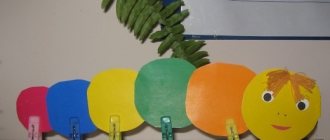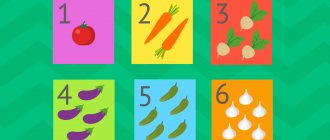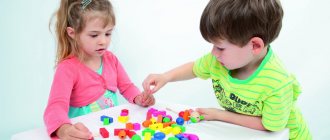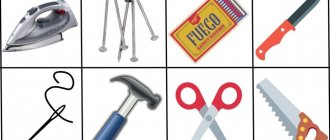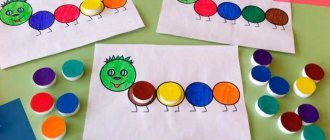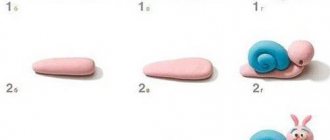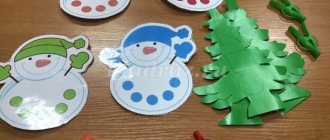"Ladybugs"
Material: cards with the image of ladybugs with a number on the left wing; numbered cards for the second wing; numbers in circles.
Options for using the guide:
1. The teacher places a number in a circle above the ladybugs and invites the children to choose a number for the second wing. The child finds this number and attaches it to the wing.
2. The numbers are located on both wings of the ladybugs. The child needs to make a number from two numbers and find the corresponding number in the circle.
"Amanita"
Material: fly agaric caps are double-sided: white dots are glued on one side (from 1 to 10, on the other - examples; fly agaric paws with numbers from 1 to 10; white and red circles.
Options for using the instructions: 1. “Choose a stem for a hat from a fly agaric”: the task is considered completed correctly if the number of points on the hat matches the number on the stem.
2. “Solve examples”: you need to solve arithmetic examples (on the lid of the fly agaric) and find the answer (the number on the leg of the fly agaric). The task is considered completed successfully if the arithmetic example is solved correctly.
“Equal - unequal” The presenter casually places his feet on the fly agaric caps. Often the numbers on the legs do not correspond to the number of points on the caps. The child must match the number and number of points using double-sided counters. To do this, he covers the extra points on the hat with the red side of the chip and adds the missing points with the white side of the chip. The task is considered correctly completed if the number of points on the hat matches the number on the leg.
"At home"
Material: Houses with windows. There is only one room on each floor. Set of numbers.
How to play: The number on the roof indicates the number of inhabitants on each floor. The child must select and enter a number in the second window.
“Match the wheels to the car” Options for using the guide:
1. The car is given a number. Children must match the wheels to the car so that the number of dice on the two wheels, indicated by the numbers, is the number shown on the car (select all options).
2. Numbered wheels are placed on the car and the child must determine the total number of wheels and put the corresponding number on the car.
"Polyanka"
Material: Polyanka (in green cardboard); 2 types of box colors; Velcro in the center for fixing numbers on the clearing.
How to play: A number is placed in the center of the clearing. The child must make this number from flowers of different colors.
Didactic material for familiarization with the composition of the number of units in the senior group
Nelya Tkachenko
Didactic material on knowing the composition of the number of units in the senior group
Didactic material for knowledge
with a composition of people from the senior group.
SPHERE:
Forming ideas about the composition of the number inside the first bead.
TASKS:
- regulate, -
– ideas about numbers and numbers inside the first bead;
- develop,-
– the idea that all numbers are made of ones;
– the idea that the number of units in different quantities is different;
– attention, visual perception, memory, logical thinking;
– excellent motor skills;
- mention -
– organization;
– concentration;
– interest in mathematical games;
The calculation of the activity of five-year-olds in the process of systematic learning is already objectively perfect. Studying the composition of the number of units in the senior group is preparation for mastering computer technology - counting and counting one at a time.
What else to read: Fairy tales about geometric shapes, interesting facts about mathematics
The study of the composition of numbers from units should begin with an analysis of the composition of a set of elements to the composition of a number of units, while one should be consistent, not hasty, and from the heel - from each number - from 2 to 5 (2, 3,4,5)
... For illustrative purposes of the material, a group of objects of the same type is selected, each of which differs from each other in qualitative characteristics (for example, color, size) ... In addition, elements that are united by a concept are used in the future, for example, sets of clothes, dishes, furniture, etc. etc. Along with texture elements, you can use patterns of geometric shapes, strips of paper of different lengths and sizes, etc. It is necessary to teach children, when looking at the sets, to tell how this group is composed, to name each element and their total number.
For example:
“The number 4 consists of the following: 1 green circle, 1 red circle. 1 yellow circle, 1 blue circle – 4 circles in total.”
After counting 4 circles, the child must say how it is composed “that’s four”
emphasizing the number of composition: one - green, one - red, one - yellow, one - blue, four in total. When inviting children to do tasks with different types of groups of objects, you should ask them to say how the group is made up, how many different objects there are and how many there are in total, to name both the objects and their number. Gradually you should move from more specific questions to general ones: “How much did you receive? How much... in total? How do you... (for example, 5 pencils?"
When studying the quantitative composition of a number of units, it is necessary to draw children's attention to the fact that a unit can reflect not only an individual object, but can be a reflection of an entire group of objects. For example, invite children to look at a variety of geometric shapes and answer questions:
– What parts does this set consist of? ("Compiled in three parts"
.
– Name the color and number of parts of this set. (“This set consists of three parts of different colors: one part is red triangles, one is blue triangles, the third is green triangles. There are three parts in total.”
– How many units does the number three consist of? ("Of three separate units"
).
In this task, children must understand that a unit can reflect not only an individual object, but also a group of objects.
In the process of familiarizing children with the composition of a number of units, you can use verbal exercises, -
– forest animals gathered in the clearing: a hare, a hedgehog, a squirrel. How many animals are gathered in the forest clearing? How many different forest animals have gathered in the clearing, etc.
And other tasks, for example -
– take five triangles of different colors;
– draw three different geometric shapes;
– put four different dolls on the table, etc.
Familiarization of children with the composition of a number is carried out in a sequential system of classes, which creates conditions for the formation of new connections that form children's knowledge of quantitative composition, which in turn is preparation for computing activities.
Every number can be made from two numbers
The next step in teaching is to let your child understand that every number can be made up of two numbers, each of which is smaller than itself. For example, two is 1 and 1, and four is 1 and 3 or 2 and 2. Make all possible combinations, for example, five can be represented as 2 and 3 or 3 and 2. At the same stage, include in the composition of the numbers zero: each of them can be counted as the sum of itself and zero: three is 0 and 3 or 3 and 0.
Let the child remember one of the first arithmetic rules: Any number can be represented as the sum of 0 and the same number.
Also use objects in teaching - this will make it easier for a preschooler to understand the principle of decomposing numbers into individual components, and in the future he will be able to count without problems. Later you can move on to written exercises. One of the most famous is the “Number House”. On each floor of this conventional house there are two apartments, and only a certain number of people can live in them, for example, only 4. Together with your child, “populate” the residents in apartments, making sure that their total number (the number in the window) does not exceed specified in the task. An adult can write numbers in the boxes at first, but such activities are an excellent opportunity for a child to get acquainted with what numbers look like on paper or a computer screen and to practice writing them.
Captains lived in these houses. One day all the captains quarreled and left their “apartments”. We must reconcile them and put them back in their “apartments.”
Look what number is written on the roof of this house? (5)
How many captains should live on each floor? (5)
(Each child works on the composition of the number 5. And the child who completed it the fastest displays this composition of the number in a large house
).
Instead of a house, you can use other pictures, for example, a Christmas tree with Christmas toys. You can draw the images yourself, download them from the Internet, or adapt regular coloring books for classes.
After graphic exercises, the child will be ready to perform a similar decomposition in his mind, without using fingers or other objects. This means that in the future he will be able to do mental calculations without problems in mathematics.
Nice bonus: Exercise Missing numbers (76.2 KB)
Mathematics Requirements
A child masters counting on average at four years of age. By this age, he is able to count objects and name their quantity. By first grade, the child should also be able to add numbers in his head within ten. Be able to write these numbers and subtract them. In addition, the preschooler must know the composition of the number. How to explain the composition of numbers to a child? Actually, it's not that difficult. The composition of a number is at least two numbers, the addition of which results in the original number. How to explain the composition of a number to a child? First, you need to understand this definition yourself.
How to explain to a child the composition of numbers: option two
You can take a piece of paper and a pen. How to clearly explain to a child the composition of a number with their help. You can write any number on the piece of paper. For example, seven. You must write in the middle of the line. From seven you need to draw two arrows down. Under one write the numbers from one to six. Under the other - the same thing, but in reverse order. You will get two columns with numbers. Opposite the six there will be a one, opposite the two there will be a five, opposite the three there will be a four and so on. An addition sign should be placed between the numbers. It will clearly become clear that seven consists of the sum of one and six, the sum of two and five, three and four, and further down the list. In this simple way, seven becomes decomposed into two numbers, the sum of which gives the original value.
Abacus
Another simple way to explain the composition of numbers is the usual abacus. Now this tool is not particularly popular. This is due to the great availability of electronic computing tools (calculators). However, they can still be seen in small counter-type shops. There are ten dominoes on each wire of the abacus. By moving the dice from one end to the other, you can also visually learn the composition of the number ten. The abacus is also a great way to learn adding numbers from one to ten.
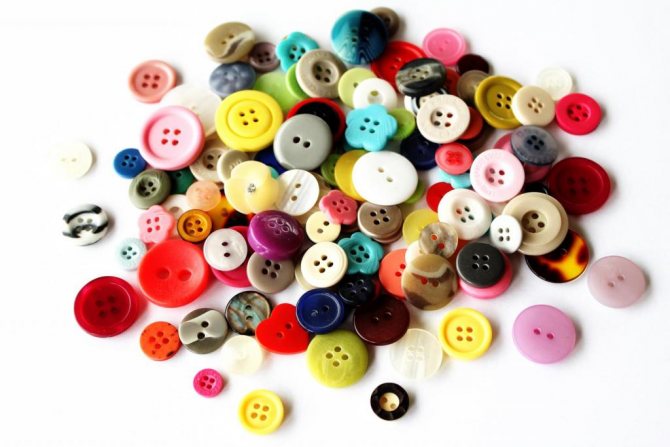
How to explain to a child the composition of numbers up to 10?
The option with a house is also very suitable for explaining. How to explain to a child the composition of numbers using this technique? You need to draw a house on a piece of paper. In the triangular roof you need to write the number ten. The main part of the building must be divided into two halves vertically. Next, the house must be divided into ten floors. In the resulting left column you should write the numbers from zero to ten, in the right column, respectively, in the reverse order. It turns out that on one floor there are zero and ten adjacent, on the next - one and nine, then - two and eight, and so on. Such houses are very visual and can be made for any number up to ten. More is possible, but it is not advisable.
You can draw houses together with your child. You can decorate them or even make them with applique. Here everyone is guided by their imagination. These images can be taken with you to school or preparatory classes. An interesting option for making a house would be a craft with opening windows. It is a little more difficult to make, but the child will perceive this method of explanation as an exciting game.
To begin, you will need two identical sheets of paper. One shows a house with floors. An opening window is cut out in each of them. This sheet with the image of the house should be glued to the second sheet. You have to be careful here. The windows should not be glued to the second sheet. In each box you should write the required number. The windows can be closed. The child must himself remember the number hidden in the window.
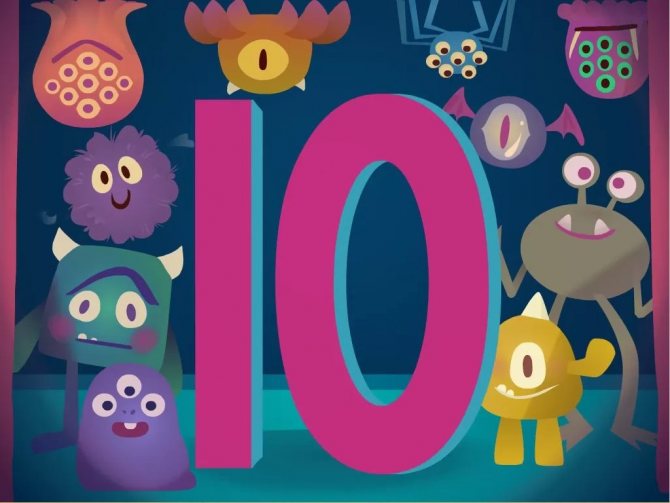
Dominoes and buttons
Dominoes can be used to explain the composition of numbers up to six. You don't have to draw anything, the dots are already marked. The convenience of this method is that with the help of dominoes you can begin to explain the composition of the number much earlier than such a need arises. Almost all mothers play children's dominoes with their kids. Around the age of five, you can safely introduce your child not only to the game, but also to the composition of numbers.
Another handy material for getting to know the composition of a number is buttons or beads. The advantage of the beads is that they look the same. If there are no beads, then you can use ordinary buttons. The principle of dating is the same as using counting sticks. You should buy identical buttons in advance. You can also use what you have on hand at home.
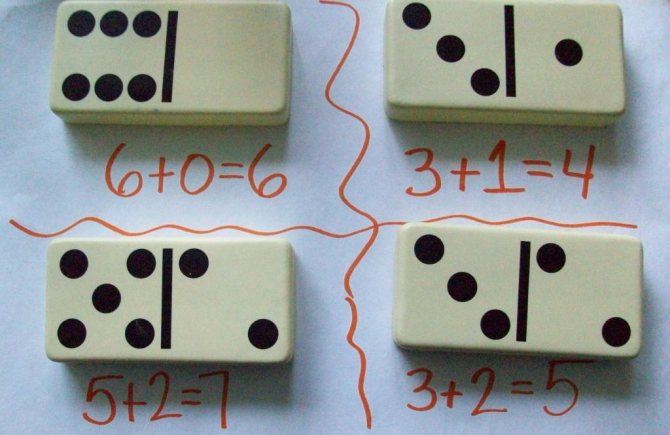
Admission to school
At the moment, there are no official requirements for a child in terms of skills and abilities when entering first grade. However, at almost every school and every children's club there are courses for preparing first-graders. In kindergartens, the last year of study is also combined with the period of preparation for school. In order to get to a good teacher at the best school, a child upon admission must be able to read, write basic words, add, subtract and reason. Mastering these skills can be entrusted to teachers, but you can also master the necessary training yourself with your child.
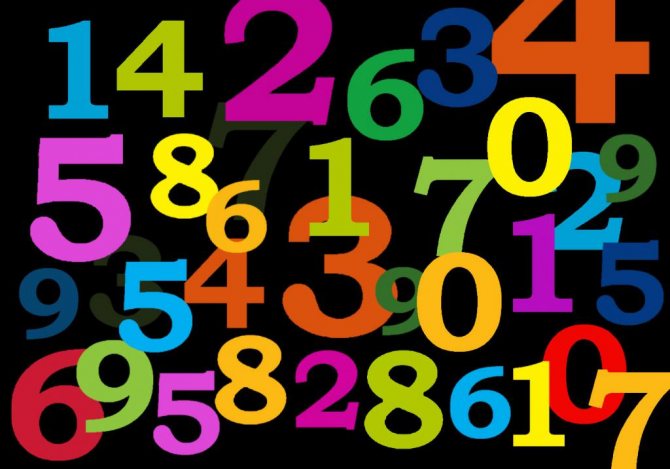
What is the composition of the number needed for?
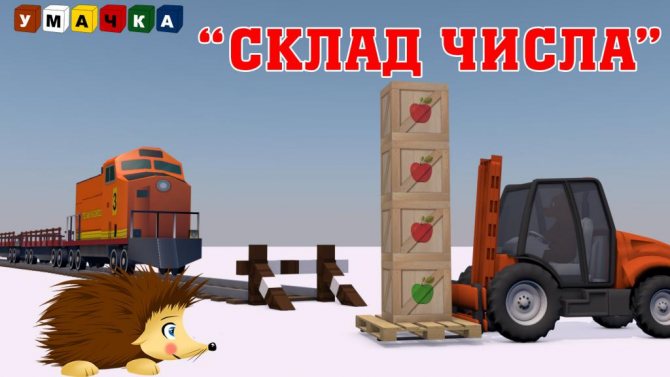
In addition to the fact that the composition is needed for studying at school, it has very important practical significance. With its help, we mentally perform elementary operations of addition and subtraction. The ability to decompose a number into its components allows us to add and subtract within a thousand. Understanding the very principle of decomposition into component numbers is very important in everyday life.
There is even an addition table. It can be up to ten, up to twenty and up to a hundred. These tables are best learned as multiplication tables. Any simple arithmetic operations are based on the decomposition of a number into its composition. Despite the abundance of calculators in the modern world, the need to count mentally still does not disappear. Sometimes the speed of mental arithmetic is faster than the search and use of a computational tool. And memory training never hurt anyone.

